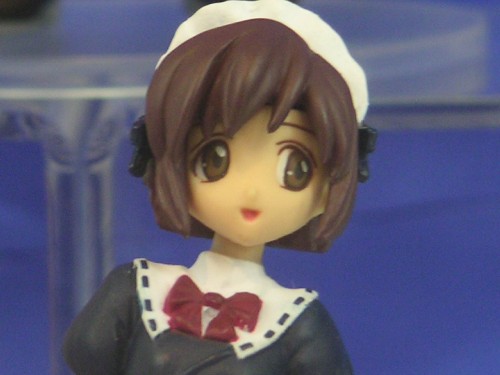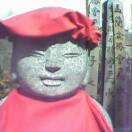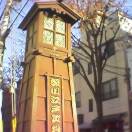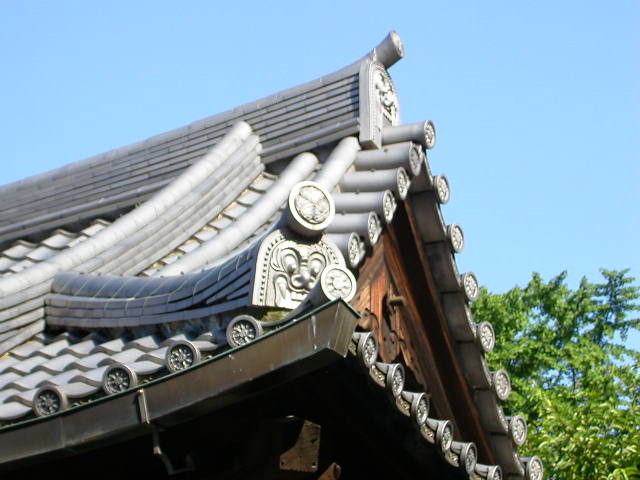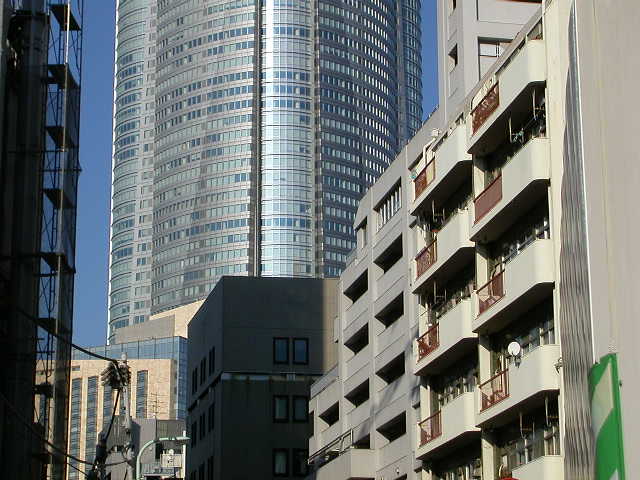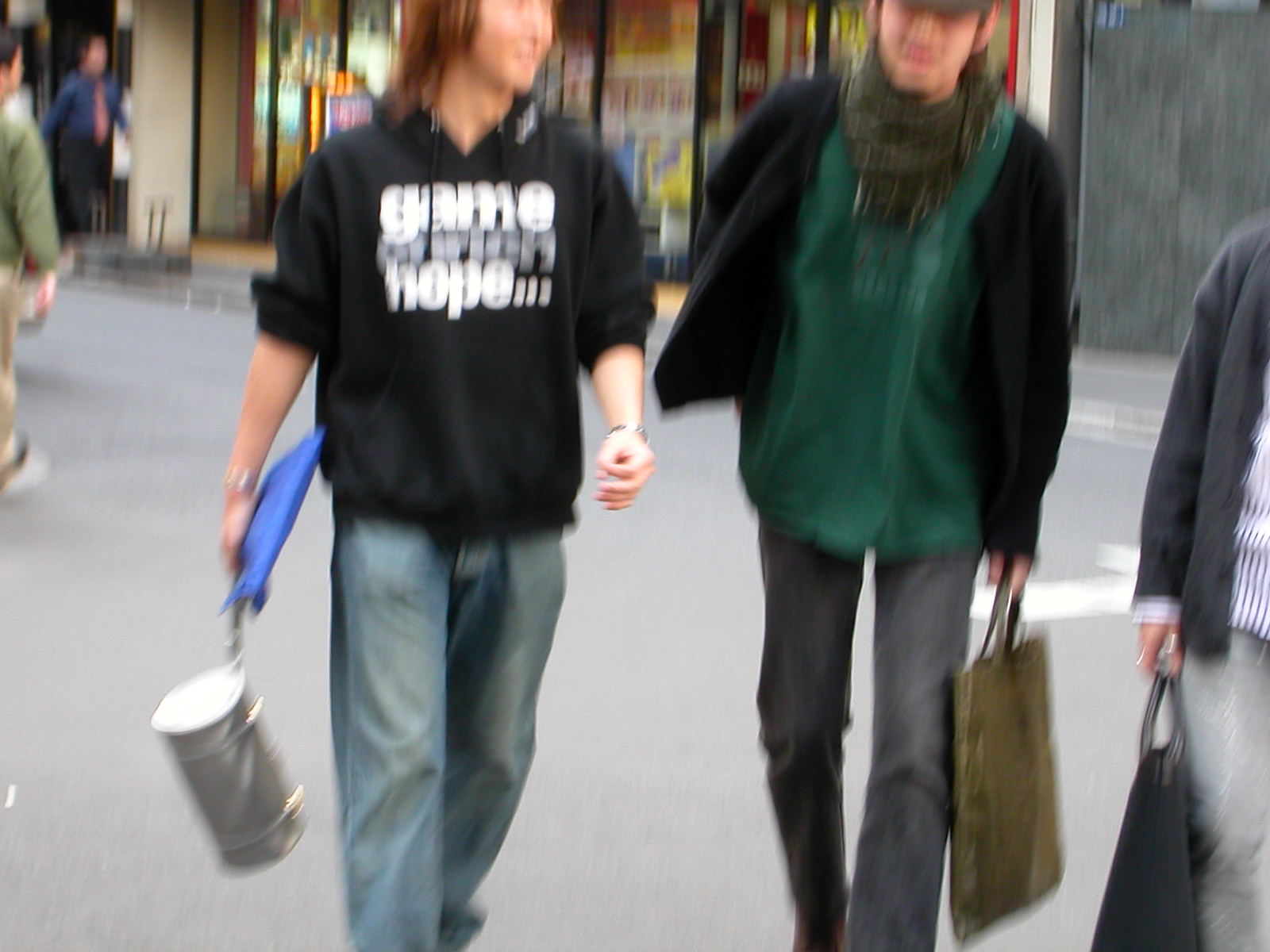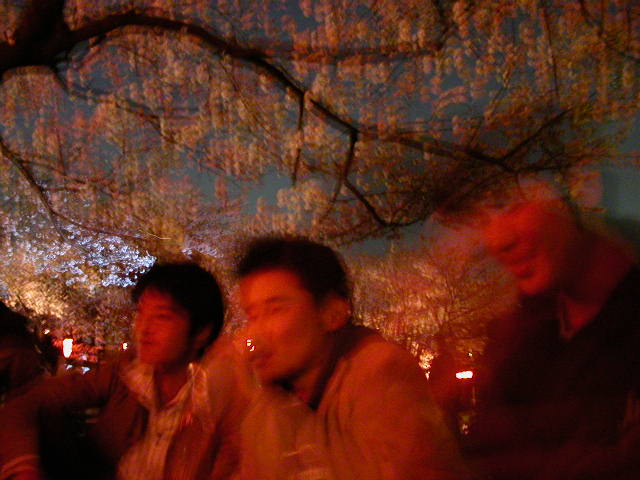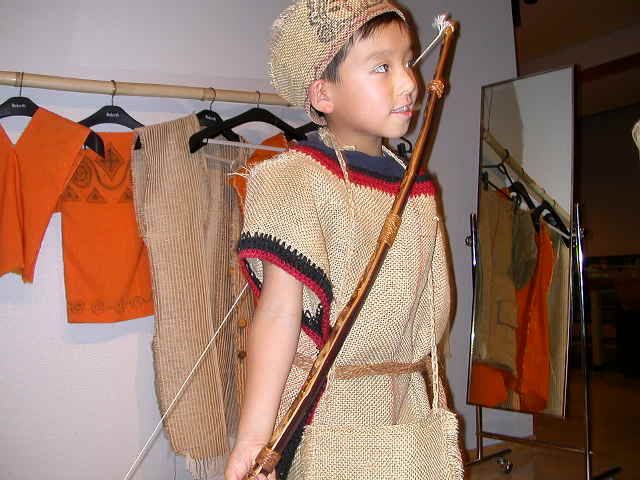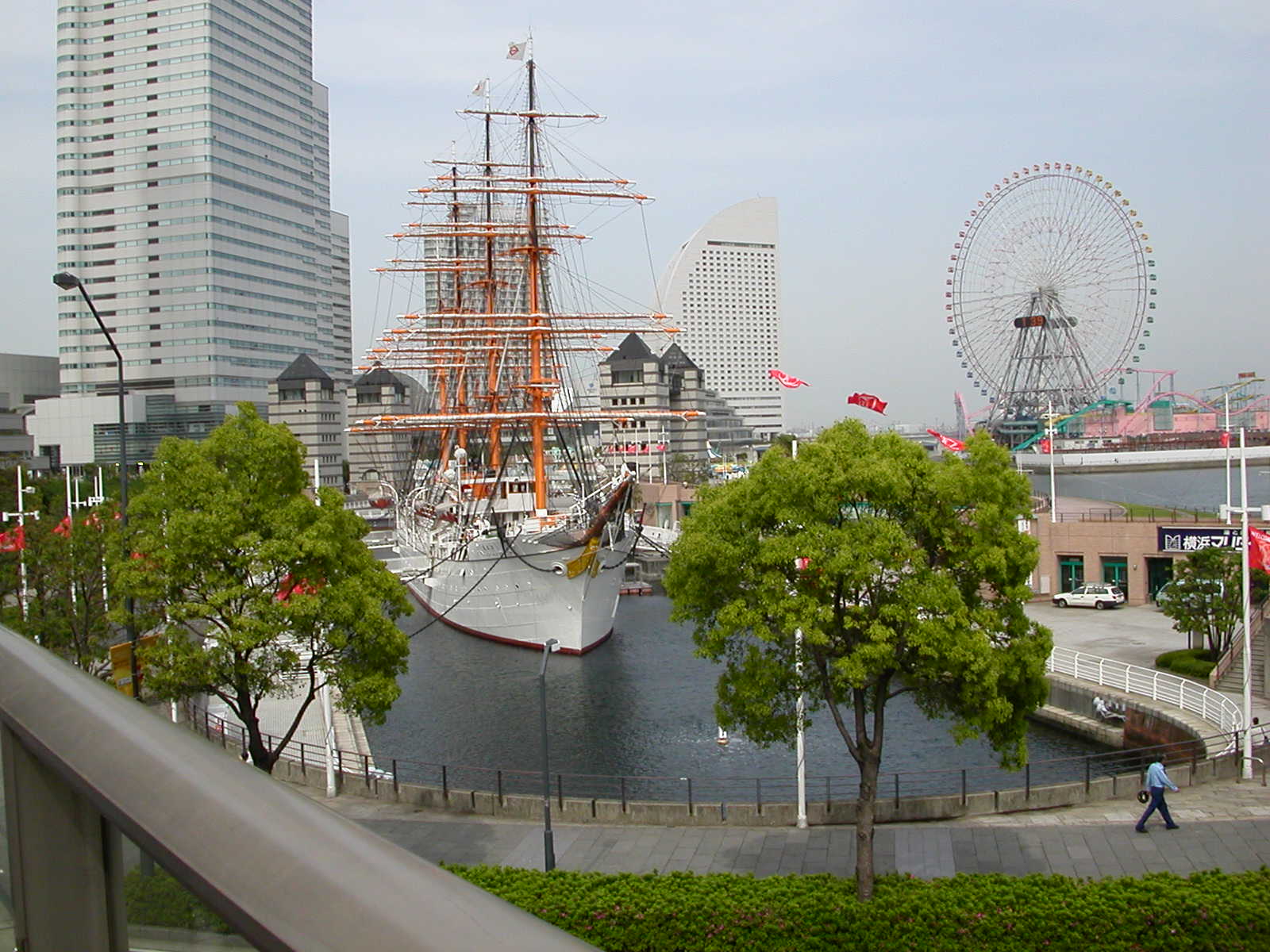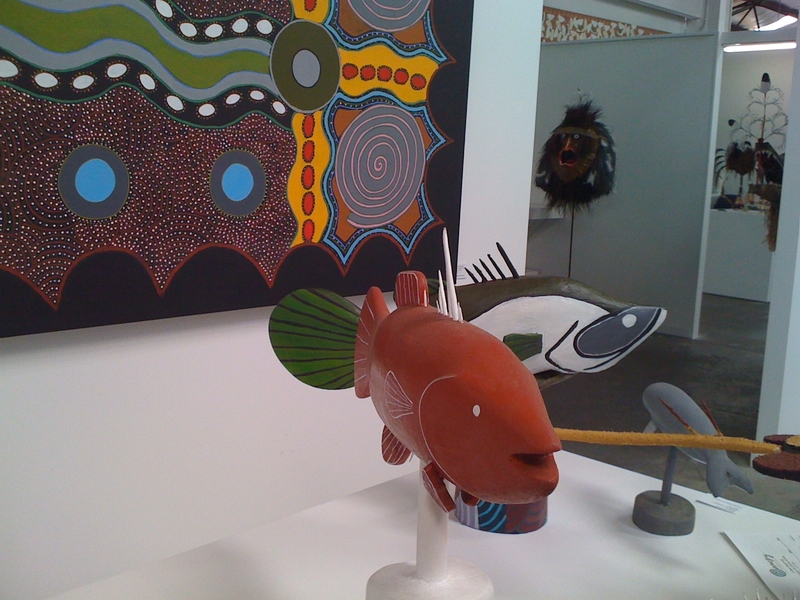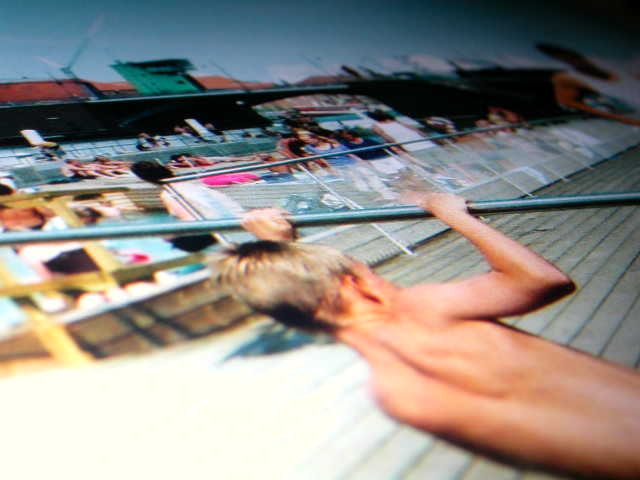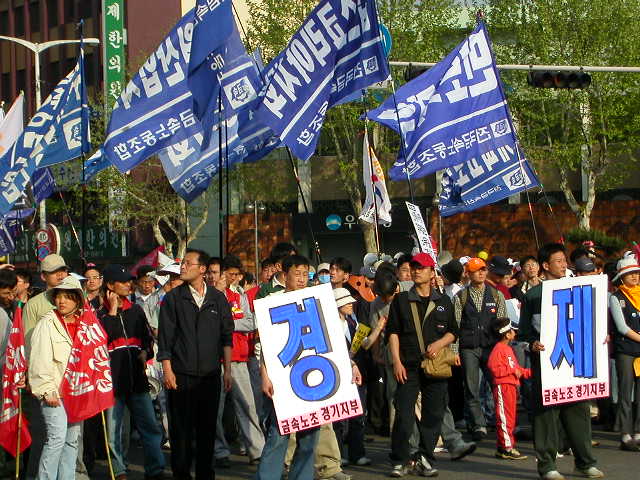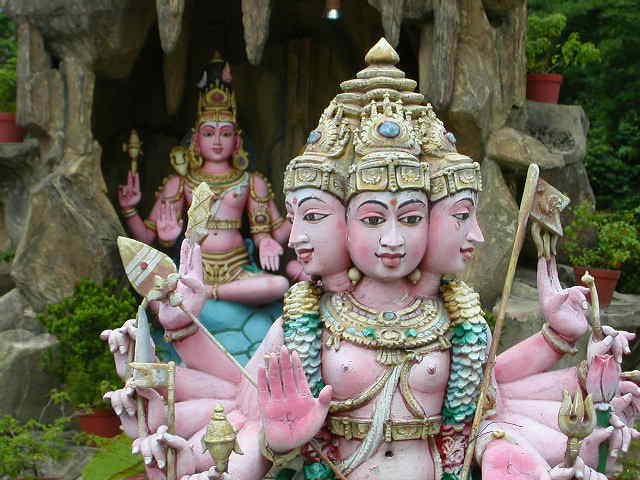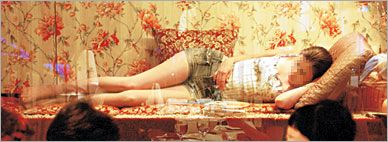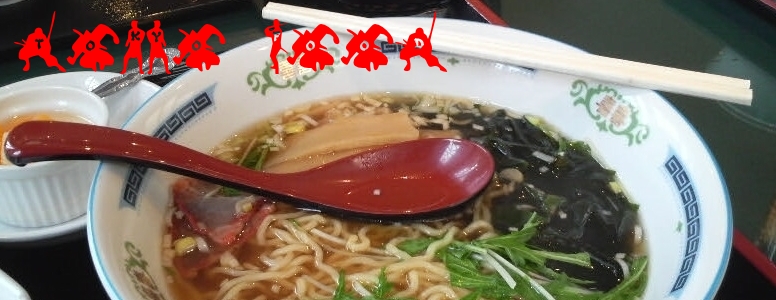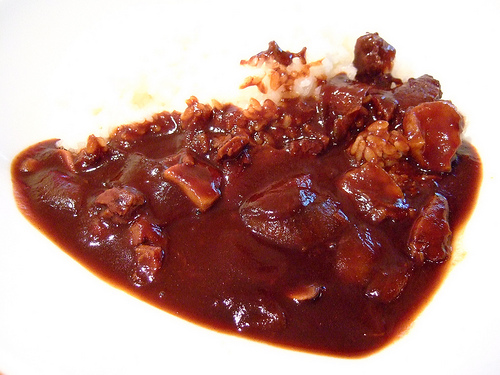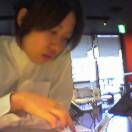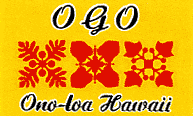| |||||||||||||||||
Wednesday, May 05, 2010
Ikea (Minami Funabashi)
WHILE I HAVE BEEN YEARNING TO RETURN TO EUROPE FOR YEARS NOW, CONDITIONS IN MY LIFE HAVE KEPT ME CONFINED FAIRLY FIRMLY TO ASIA. Hopefully I won't be locked into this pattern forever, but for the meantime I have been forced to make the most of it, and enjoy having my miles clipped. In the process I have discovered that even if you can't make it to Europe, there are certain places in Asia which have a pseudo-European scene, which can make you feel like you are almost there. If you like Drum&Bass music you don't have to go all the way to London to hear it, since many of its best DJ's have migrated to Khao San Road in Bangkok, Thailand. On the more sedate side, Japan is full of tiny European theme parks, like that resort in Nagasaki which pretends to be a Dutch town, which can simulate the feeling of being in a foreign land. The Ikea showroom in Minami Funabashi, not so far from my house, is the latest European portal to open in Tokyo. Well, it is not quite Tokyo, but it is close enough (in the adjoining Chiba Prefecture). It is also not quite a portal, more a celebration in consumerism. But it is close to my house, and there are actually real Swedes working here (and shopping, too.) At times like this when I can't afford to go to Sweden, I can always go to Ikea at Minami Funabashi, and have a little taste of Swedish minimalism. Of course the setting, amidst the concrete wastelands of Chiba Prefecture, is about as un-Swedish as you could imagine. (For the complete Ikea review, click here.)

Thursday, April 23, 2009
Gaboh (Asakusa)
FINALLY, THIS WAS IT. After months of false starts, broken promises, and misguided hopes, now I had the chance to eat in a quality Japanese restaurant, and blog about it. With plenty of nice photographs. After eight years of living in Japan, my parents had decided to deign me a visit, a Royal visit no less. So it was up to me to entertain them for the duration of their stay. I turned to my Asakua contact Mrs Sasaki for help. She aspires to be a guide for tourists in Asakusa, so this was a golden opportunity for her. Deciding things to do and places to go in Asakusa was a no brainer; determining where to eat proved a little more tedious. Like many of her people, Mrs Sasaki is of the opinion that foreigners cannot eat real Japanese food. By real Japanese food I mean raw fish, tsukuemono pickled vegetables, and seaweed. All of these are present in abundance at Gabou, a restaurant on Kokusai Dori ("International Street"), right next to the drum museum near Tawaramachi Station. Which is why I was surprised that in the end this was the place that Mrs Sasaki made a booking at. I was expecting her to book my folks into some yaki niku joint instead, something more gaijin friendly. Something with steaks and spaghetti on the menu. The Gaboh homepage doesn't even have an English language section, let alone an English menu. The restaurant's name roughly translates as "Our Room" -- that is a very rough translation, but gives you an indication where they are coming from! This is old school Japanese ryouri! (For the complete Gaboh review, click here.)
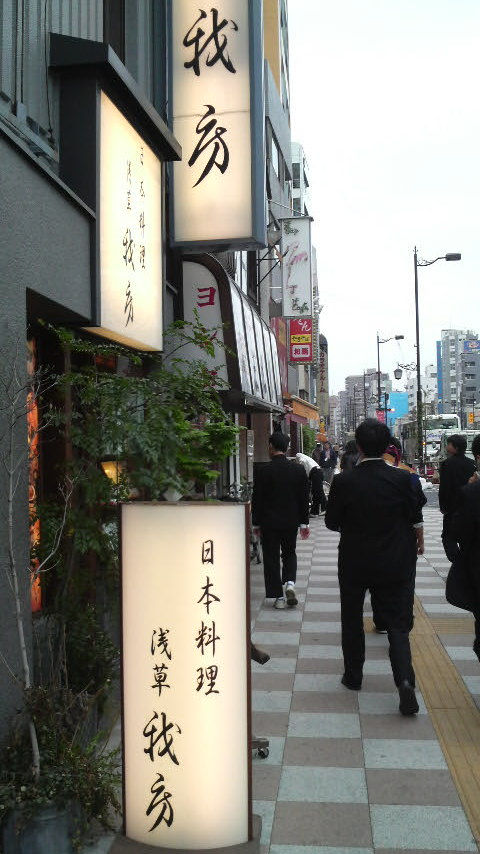
Wednesday, April 22, 2009
Heijouen (Asakusa)
I HAVE ACTUALLY DINED AT THIS PLACE A COUPLE OF TIMES OVER THE YEARS. Once with Jeremy and my mate Kenichi, around the time I helped Jeremy score his job at World Family. A few years later when I myself scored a job at World Family, I lunched with Kenichi to celebrate my new work regime. About two and a half years after that, entertaining my parents during their first trip to Japan, I found myself near Kaminarimon ("Thunder Gate") in Asakusa, almost as if by chance, looking for a place for lunch. My Mum had been wanting to meet Kenichi for a long time, ever since he helped me out when I was locked up by the Tokyo police for 16 days, back in 2007. When I am in Shibuya and I want to meet someone, Hachiko (the "faithful dog" statue) is the obvious place to meet. In Shinjuku, out the front of the Alta department store is the popular meet and greet location. In Asakusa, Kaminarimon is one logical landmark, but in the spur of the moment, as I talked to Kenichi on the cellphone, an idea sprung into my mind: why not meet up together next to those golden bulls just down the street? And if my folks were accommodating, why not eat lunch inside the restaurant those streetside livestock represented? Old Japanese folk in tour buses waved to us as we passed. We must have looked a sight, standing amidst those golden bulls. I suppose not many foreign families come to this kind of place for lunch. That said, this is precisely the kind of Japanese food experience that many foreigners would feel most comfortable with. For starters, it is DIY, and barbeque centred, with meat being the most important dish. As Wikipedia records: "Yakiniku (焼き肉 or 焼肉), meaning "grilled meat", is a Japanese term which, in its broadest sense, refers to grilled meat dishes. Today, it commonly refers to a Japanese style of cooking bite-sized meat (usually beef and offal) and vegetables on gridirons or griddles over flame of wood charcoals carbonized by dry distillation (sumibi, 炭火) or gas/electric grill. In North America, China and Taiwan, Yakiniku is also referred to as either "Japanese barbecue" or "Korean barbecue" [1][2] due to its Korean origins." It is thought to have originated from horumonyaki, a dish of grilled offal, invented by Korean immigrants in the Kansai area after the Second World War." Testifying to the Korean origins of the genre, there was plenty of kim'chi on the table. However, there was plenty of Japanese miso soup too... (For the complete Heijouen review, click here.)
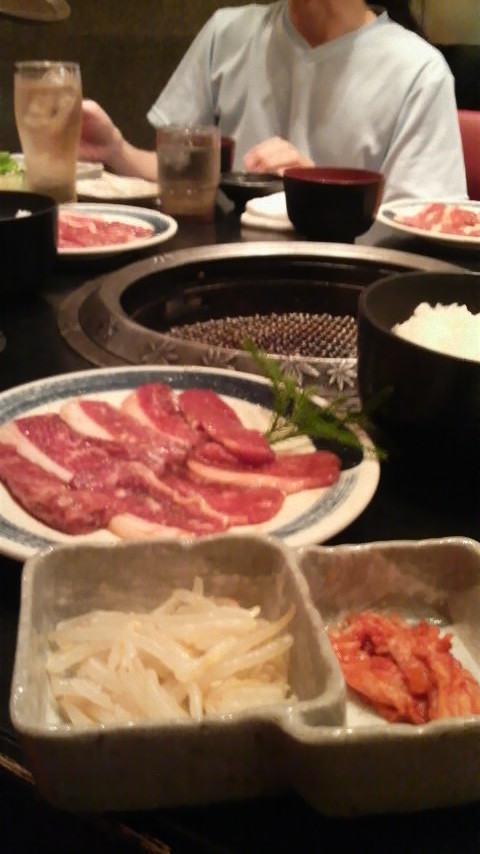
Friday, June 20, 2008
Mugitoro (Asakusa)
FOR THE PAST FEW WEEKS THE WAY I LOOK AT JAPAN HAS BEEN MYSTERIOUSLY TURNED ON ITS HEAD, TWISTED AROUND, AND PUNCTURED THROUGH, THANKS TO THE INFLUENCE OF A LITTLE BOOK, WHICH I BOUGHT WITH A GIFT VOUCHER WHICH MY TELEPHONE COMPANY GAVE ME WHEN I WON EMPLOYEE OF THE MONTH (AGAIN). The book is The Empire of Signs by Roland Barthes, the French semiologist, who made a trip to Tokyo in the late 1960s. After visiting Japan, Barthes concluded that emptiness was the essence of Japanese culture. In his 1970 book Barthes realized Japan as an immense reservoir of empty signs. Packages, bows of respect, the lack of a logical, ordered system for addresses of domiciles in towns and cities. The complete lack of street names. Framed by void and framing nothing (or framing a nothing), the Japanese thing shows itself as essentially form and emptiness, spotlighted on a matte black background. The funny thing is, I had already noticed that matte black background effect in Japan, but I just didn't have the words to think it, and express it, until I read Barthes. Countless times walking around Tokyo, starting with one grey afternoon on the crunching gravel of Yoyogi Park, I have had glimpses of the void -- each person walking in their own void, flung out to the corners of the cosmos, by a universe which is inflating even as we speak. Starting with one bustling hot afternoon near Kanda Station, I have experienced this repeating episode: it is like I am not even there, and all that exists is the world around me. Like a movie that nobody is watching, or a TV playing in an empty room. Alternatively, sometimes it is the outer world which drops away, and I feel a kind of spotlight swing on to me. Finally I understand: this is my show, it is showtime, and I am an actor on the stage (and there is nobody in the audience to watch it.) What a revelation -- it (life) was all just a game for me, a manifestation of my soul! A TV playing in an empty room -- an actor on the stage and there is nobody in the audience to watch him or her perform. These are both original Zen koans of mine and if you concentrate on them hard enough, you will reach satori! At least I have, on the odd occasion, thanks to concentration and the aid of herbal highs. Books can be a form of natural high and the ultimate smart drug. Reading Barthes' book has taken me to a deeper level of understanding, and totally rejuvenated my relationship with Japan. Curiously enough, it has also ignited my interest in Japanese food.
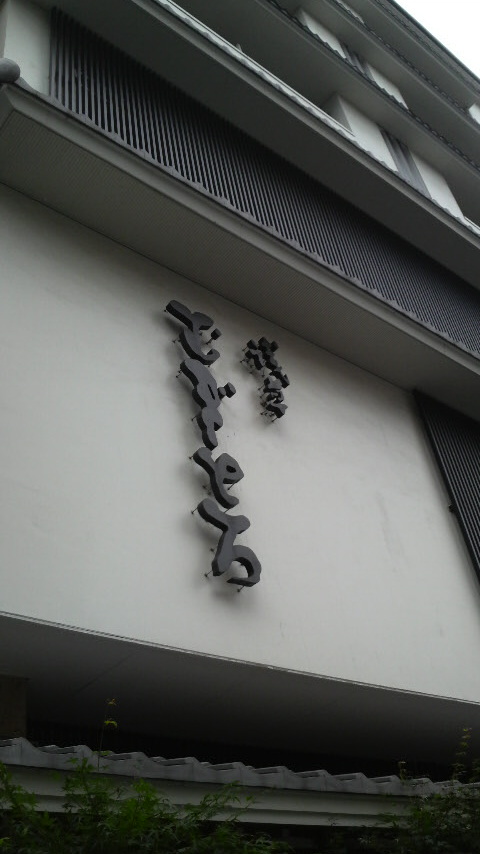
Today I finally had a chance to encounter tororo, and devour it en masse. If Japan is indeed the land of emptiness and empty signs, then you couldn't get an emptier cuisine, than tororo cuisine. It is certainly almost zero calorywise, and approaches the void when it comes to a discernible taste, too. But nonetheless, is filling, and it is hearty, and it is healthy. This is a traditional Japanese, as one Japanese language blooger posted. Mugitoro is Tororo and Mugi-gohan (rice boiled with barley). It is said that these are very healthy foods. This photograph is a restaurant of "Mugitoro" in Asakusa. I went there with my Friday noontime student Mrs Sasaki, still reeling from my loss of deep Friday morning lie ins. It was a gray day in the heart of the rainy season. "Tororo" is Yam. (For the complete Mugitoro review, click here.)
Sunday, June 17, 2007
Shuns Rolls (Roppongi)
 Here is a story I had published in the Tokyo Notice Board magazine last year, a review of a fusion sushi
restaurant called Shuns Rolls, in Roppongi.
Here is a story I had published in the Tokyo Notice Board magazine last year, a review of a fusion sushi
restaurant called Shuns Rolls, in Roppongi.Put up your hands everyone who had wrong ideas about Japan before you came here? Japan is one of those countries which invites endless misconceptions and fanciful stereotypes. It's only natural, given that most people learn all they know about Japan from watching anime and movies like "Lost in Translation". In the food department, if your introduction to Japanese cuisine took place in a strobe-lit New York City cellar packed with models and movie stars, you might be surprised when you finally come to Japan. For starters, you won't find California roll on the menu at many old-school style Japanese sushi restaurants. You probably won't find other foreign inventions like the spider rolls or rainbows either. That is, unless you go to one of the new Japanese/Fusion restaurants, such as Shuns Rolls at Roppongi.
If you can imagine what would happen if you gave a Spanish tapas taverna bar the Japanese treatment, you might end up with something like Shuns Rolls. Alternatively, Shuns Rolls is a recreation of a New York style Japanese restaurant, which in turn is a recreation of the restaurants here. This is a standing bar, with bite-sized dishes to accompany the copious selection of beers, sho-chu's, cocktails, and other beverages. Sushi features prominently on the menu, but it is not the kind of sushi you find in the typical suburban kaiten. According to manager Shuntaro Sato, this is Japanese food reflected through a contemporary European/American prism. Spanish and French ingredients, like Iberico and pate respectively, feature prominently. For those whose throats gag instinctively at the sight of raw fish, you will be pleasantly surprized by the menu at Shun Rolls. There is indeed a lot of raw fish, but the rolls also come wrapped in blow-torched Iberico ham, or infused with spicy Korean kochijan sauce. On the counter, there are other alcohol-friendly nibblies like beef jerky. Shuntaro the manager has the Japanese knack for punning and ramming multiple meanings into the one name: "Shun" alternatively means "the hot spot", "fresh" and is also the guy's first name. He said the biggest drawcard of his standing bar is the friendly staff, who at the moment are all dressed in Japanese national soccer team uniforms, in preparation for the coming World Cup. "The staff who work here are so good looking, a lot of Japanese girls come here just to check them out," he said. "We also get a lot of foreign people coming here, European people, Spanish people, they are looking for food which is both Japanese and international at the same time."




c o u n t r y & w e s t e r n + c u i s i n e
 THAT'S RIGHT THEY HAVE COUNTRY AND WESTERN MUSIC IN JAPAN -- and what's more, they have plenty of bars and cafes and restaurants where country music lovers can gather and play a little guitar or harmonica, yodel a bit if that makes them feel at home, and basically chill out. I should know, because one of my best friends in Japan is a country music freak, and he has taken me to plenty of country&western bars. The first time we went out, sometime in 2004 if I remember correctly, to a place called Two Beat in the futuristic depths of Shimbashi, I was so surprised and culture shocked by what I saw. Outside it might have been a blur of blacksuited salarymen and OL's (office ladies) beneath gleaming concrete towers and Oriental skies, but down a single flight of stairs, a little piece of the American midWest had been created, with the perfect attention to detail that only the Japanese can pull off. Blacksuited salarymen (tie loosened) were drinking American beers and grazing from baskets of peanuts and occasionally having a go at the mike to sing some country karaoke classics. From time to time, ardent and spotlessly perfect sessions of yodelling would break out. As the only gaijin (foreigner) in the place I was automatically assumed to be a country&western expert (even though I am not) and I was always been badgered to sing something in front of the group. I ended up singing Country Roads by John Denver and Guns and Roses' Patience -- this latter song not really country I know, but it is as country as I get...
THAT'S RIGHT THEY HAVE COUNTRY AND WESTERN MUSIC IN JAPAN -- and what's more, they have plenty of bars and cafes and restaurants where country music lovers can gather and play a little guitar or harmonica, yodel a bit if that makes them feel at home, and basically chill out. I should know, because one of my best friends in Japan is a country music freak, and he has taken me to plenty of country&western bars. The first time we went out, sometime in 2004 if I remember correctly, to a place called Two Beat in the futuristic depths of Shimbashi, I was so surprised and culture shocked by what I saw. Outside it might have been a blur of blacksuited salarymen and OL's (office ladies) beneath gleaming concrete towers and Oriental skies, but down a single flight of stairs, a little piece of the American midWest had been created, with the perfect attention to detail that only the Japanese can pull off. Blacksuited salarymen (tie loosened) were drinking American beers and grazing from baskets of peanuts and occasionally having a go at the mike to sing some country karaoke classics. From time to time, ardent and spotlessly perfect sessions of yodelling would break out. As the only gaijin (foreigner) in the place I was automatically assumed to be a country&western expert (even though I am not) and I was always been badgered to sing something in front of the group. I ended up singing Country Roads by John Denver and Guns and Roses' Patience -- this latter song not really country I know, but it is as country as I get...
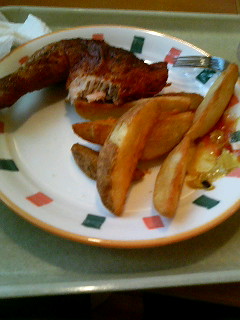 Harvester Chicken: Harajuku. Phone: 03/3843 2861.
Harvester Chicken: Harajuku. Phone: 03/3843 2861.After paying some money off my credit card this afternoon, I walked up the road to the Telephone English job in Shinjuku. On the way I passed a restaurant called Harvester Chicken which I have often noted, but never dined at. Since I was feeling pretty hungry, I decided to have lunch here. I was surprised to find they serve chicken and chips just like the takeaways in Australia -- this is the first time I have found this kind of food in Japan. And to be honest, it tasted much better than the chicken and chips you get in the greasespoon takeaways in Australia -- since it is Japan, the emphasis was on quality rather than quantity. You can see by the photo that the serving was small (one reason why Japanese people are so slim!) But every chip was a delight to eat and the chicken tasted wonderful. Since it is on the way to my work, I am sure I will be stopping there for lunch again regularly in the future! As Rotten Tomatoes hath reported: "This time, unlike previous times, I brought along my computer since the hotel has free high-speed cable (nifty, eh?). "Today I went to Shinjuku and Harajuku. I put the "Do Not Disturb" sign on the door so I could sleep in (if you'd call 9am, "sleeping in") as they make up the rooms at 9am. Gargh! "But that's the one (slightly annoying) thing about the hotel. Other than the free high-speed cable, it's also close to the subway station, post office, Starbucks, and the Tokyo City Air Terminal (for buses to and from Narita), which I'll no doubt be using in a month's time when it's time to go home. "So! I arrived in Shinjuku around 11am, and started off looking in Odakyu and Keio department stores. Then I had lunch at Excelsior Cafe, down the road from the station, which has kick arse food (I had a roast chicken and tomato pita-thing). Then to Takashimaya Times Square, which is huge, with 12 levels, and then to the crepe shop near My Lord for a Strawberry Milk Ice crepe . . . just like last time! To the booth stores again (just like last time, too . . . what can I say, I'm nostalgic) where I discovered there's a new Chibigyarari line, so I bought some folders, pencils, stickers and paper. Yay! "After this, it was off to nearby Harajuku, for a 3pm visit to Meiji Jingu. I visited Meiji Jingu back in April 2004 on my first trip to Tokyo, but I was still getting the hang of my digital camera at the time so my photos were rather ordinary (or, specifically, they were horribly over-exposed). I love the park (Yoyogi) surrounding Meiji Jingu. It's huge, with wide paths with crunchy gravel (yes, mentioning the crunchy gravel is important), and old, old trees. It's amazing that it's in the middle of Tokyo, but you can really just walk through there and forget you're in Tokyo. It wasn't too crowded today, which was great, so I took my time strolling around and taking photos. "After this, I went down Ometosando in Harajuku (one of the main streets) and went to Kiddy Land (ehehehe . . . which I always enjoy . . . ) and then back up the street to have afternoon tea slash dinner. I saw this rather appealing-looking chicken and salad sandwich in a photo on a menu outside a restuarant, and then I saw the price - 1300 yen (ahem, $13 USD for a sandwich). Screw that! "So I kept walking, and noticed a sign above The Harvester proclaiming that there was roast chicken to be had inside. Roast chicken?! Yay! So I had a roast chicken pita thingy (different than the one at Excelsior) and potato wedges. They played country music in there, I was waiting for a Garth-Brooks-wannabe to turn up and start boot-scooting any second, but it didn't happen (funny, that). Instead, I sat there imagining I was in some bar in the Southern US (where the real boot-scooting happens . . . I think . . . ). The illusion was working until the Japanese waitress came over asking if I wanted a drink refill..."




e a t i n g + e e l s
EEL IS ONE OF THE WONDER FOODS EATEN IN JAPAN. I am sure it is a superfood. Some of the places you can eat it in Tokyo are:
Eel Restaurant Koyanagi: 1-29-11 Asakusa, Taito Ward. Phone: 03/3843 2861.
Natural eels from Yaizu Yoshida are cooked in this restaurant. So, you can enjoy narural tastes of eels if you aoder eel lunch Unaju. There are said to be three ways of eating eel in Japan: unaju, kabayaki, and shirayaki.. The reasonable prices are also good.
(1-7-12 Komakata, Taito Ward.)
Phone: 03/3842-4001. Website: website here. Streetview: Virtual Tokyo view here!
This is how a historic establishment should look, sombre and secluded. Dark and earthy, Dozeu sits at the opposite end of the spectrum from Mugitoro, on the other side of the street. Whereas Mugitoro is ethereal and light, Dozeu is corporeal, and challenging.. For more than 200 years they have been dishing up bowls of pond loach (鰌), a slimy eel-like fish, doused in liberal amounts of spring onion. Not for the faint-hearted! But it is old school, that is for sure.




g u r u m e + g o u r m e t
 FOR THOSE WHO BELIEVE THAT FINE DINING SHOULD
COST YOU AN ARM AND A LEG -- a selection of Tokyo's more expensive
restaurants.
FOR THOSE WHO BELIEVE THAT FINE DINING SHOULD
COST YOU AN ARM AND A LEG -- a selection of Tokyo's more expensive
restaurants.
Ichimatsu: 1-15-1 Kaminarimon, Taito Ward. Phone: 03/3841 0333.
You have to spend at least 7000 yen to really enjoy the food at this oldschool Japanese restaurant at Asakusa. Count on the company of lively geisha girls and samisen players who will saunter around the restaurant (but only at night.) Some of the dishes include fugu in a bitter orange sauce.
Sant Pau: Nihonbashi 1-6-1 Coredo Nihonbashi
Annex 1/2F. Phone: 03/3517-5700.
Chef Carme Ruscalleda's
magnificent degustation menu (21,000 yen for lunch or
dinner) is a culinary Spanish tour de force: a three-hour
cutting-edge Catalan adventure. The meal includes eight
courses, with superbly crafted dishes like stuffed calamari and
Iberian pork shoulder, but you'll also be treated to multipart
"micro menus" at either end of the meal, with bite-size surprises
like anchovy ice cream (a starter) and a tiny brochette of
rabbit and kiwi fruit. The elegant twin dining rooms are luxurious
and spacious, and the cellar includes more than 500 wines, mostly
Spanish, at all prices. Closed on Mondays.
がってん: 台東区西浅草(都営浅草駅前にも別店あり. TEL: 03-3847-1004.
日頃お気に入りの居酒屋。
やきとん・やきとりがメインで、後は黒板メニューで品が変わる。
手作りメニューだし、量も多いし、何を食べてもうまいよ!
しらすおろし(300円)、ささみ梅(300円)に焼き鳥を食べて、最後におにぎり(2個300円)でしめる。
冬は鳥つくね鍋(1人前900円)がうまい!キムチを入れてピリ辛に。
炭水化物系のメニューがもっと欲しいかな!?
やきとり各種4本400円、ビール(大)500円.
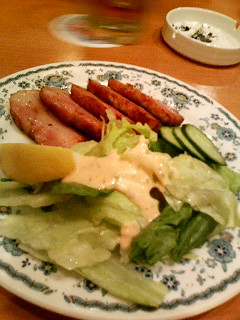



i z a k a y a + c u i s i n e -- 居酒屋
 NOW I WANT TO INTRODUCE YOU TO A UNIQUE AND MODERATELY PRICED JAPANESE DINING EXPERIENCE -- the izakaya (居酒屋). As the Greggman points out on his comprehensive site: "An Izakaya is a Japanese style bar. When you hear that Japanese businessmen go out drinking every night an Izakaya is were they go. I don't have much experience with bars in the U.S. but so far I really like Izakayas. They have all kinds of food and they serve it in small usually pretty cheap portions so you can try lots of different things. Izakayas are usually very loud places and you can often hear people playing drinking games with their co-workers. I think most Izakayas are similar but they all have different menus and specialize in different things."
NOW I WANT TO INTRODUCE YOU TO A UNIQUE AND MODERATELY PRICED JAPANESE DINING EXPERIENCE -- the izakaya (居酒屋). As the Greggman points out on his comprehensive site: "An Izakaya is a Japanese style bar. When you hear that Japanese businessmen go out drinking every night an Izakaya is were they go. I don't have much experience with bars in the U.S. but so far I really like Izakayas. They have all kinds of food and they serve it in small usually pretty cheap portions so you can try lots of different things. Izakayas are usually very loud places and you can often hear people playing drinking games with their co-workers. I think most Izakayas are similar but they all have different menus and specialize in different things."
The really crucial thing to consider is this -- the izakaya is to Japanese what the pub is to the English and Australians, and what the tapas bar is to the Spaniards. Many foreign tourists coming to Japan make the mistake of thinking that izakayas are restaurants, and thus ignore them when they want to hit the town. Foreign tourists coming to Tokyo often end up spending their nights in foriegn style bars in Roppongi and similar places, because these bars seem the closest to the traditional nightlife of the West. But this is Japan, and the concept of nightlife is a little different here. I am not knocking the foreign style bars, they do provide an environment which izakaya cannot -- for example the opportunity to meet members of the opposite sex. But you have to realize that the western style bars, by virtue of their novelty and rareness, are much more expensive than izakayas. Go to a Roppongi bar and you will pay through the nose -- drinks cost a lot more in a western style bar than an izakaya. In short, if you want to see the real Japan, go to an izakaya. Another good definition for what the izakaya is comes from the Insider View wesbite: "A bar -- a place to which you go only to drink -- is a concept that entered Japan rather late. The Japanese like to drink and eat at the same time, and izakaya is the most common establishment for that sort of entertainment. The menu in an izakaya is usually very large, containing all kinds of foods that the Japanese consider appropriate as accompaniment for drinking. There will be a few types of sashimi (raw fish), grilled and fried fish, tempura, fried items, vegetables, salads etc. One thing the Japanese do not eat when they drink is plain white rice, and therefore the kinds of rice dishes you'll find in izakaya are grilled onigiri (rice balls) or chazuke (rice with certain toppings in a bowl of green tea). Everything is served in small portions, so people usually order many dishes and share them. The local izakaya is a popular place for going out among the Japanese, and in Kansai they tend to be very lively and sometimes extremely loud. There are several izakaya chains where photos of the items appear in the menu, making it easy to order even if you cannot read Japanese. Available drinks will include beer, sake, shochu (clear liquer distilled from grains), and chuhai (a cocktail of shochu, fruit essence and soda)."
Here is a list of izakaya restaurants I have dined at during my time in Japan, ranging from small one-off places, to the major chains:
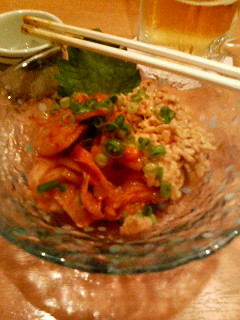 のんべ: 台東区.
のんべ: 台東区.
MAY 02 2006: I seem to have entered a phase of my life in which people are falling over themselves to invite me out to dinner in good restaurants -- and then pay for the cost of my meal. It happened last Friday when I got to sample the wares at a Ueno soba restaurant courtesy of my older friend Mr Tanaka -- scroll down the page to the soba section to read all about that expedition. Today, which was a Sunday, I was chilling out at my house when some Soka Gakkai religious freaks came around and insisted that I attend one of their religious meetings at the Ueno Koudou (auditorium) near Nippori. Now I ought to write a webpage one day about my experiences with the Soka Gakkai Buddhist sect over the years, it is such a cult -- in many ways I consider it a Japanese version of Scientology, just with less of a sense of humor, and with more losers and geeks as members. Normally I don't care too much for Soka Gakkai meetings which can be tedious to say the least, but since I want to get to know of all Japan, all aspects of Japanese society -- including the warped and cracked and the people who have been left behind -- I relented and attended. I got the usual rock star treatment being the only foreigner in the place, and thankfully they didn't ask me to make a speech. It was boring as buggery to be honest, but I hit paydirt at the end when the local Soka Gakkai leadership invited me out to one of their favorite izakaya restaurants, and the implication was, they were going to pay.
If you don't like sharing tables with missionaries, be warned that Nombe Izakaya is one of Soka Gakkai's favorite watering holes in the Ueno area. On the other hand, Nombe is a great place to relax and get drunk and try out a lot of great food. The place is located amidst a cluster of pachinko parlors and Chinese restaurants near Uguisudani Station, not far from my house. I often see foreigners in the Uguisudani area so I gather there must be hotels here in which foreign tourists stay. If you are a foreign tourist planning to stay near Uguisudani, you ought to add Nombe to your list of options in the dining and drinking sphere. The name of the restaurant, Nombe, by the way, means "drunkard" in English -- something I am often accused of being. They serve all the usual izakaya fare, like sashimi and fried squid and tofu and stuff, and all the usual range of Japanese liquors. What really took me, though, were some of the European style dishes at Nombe. There was for example one French inspired concoction of egg, cheese and spinach which the Soka Gakkai crew were so fond of, we had to order seconds. I also enjoyed the spam salad -- who could have thought that spam could be so tasty, but in Japan they make it so. Pictured above is another izakaya favorite served at Nombe -- it is called kimchi natto and it is just that, spicy Korean kim'chi on the one side, sticky/smelly Japanese natto beans on the other side. In the interests of promoting good Japanese/Korean relations, you ought to eat this dish!
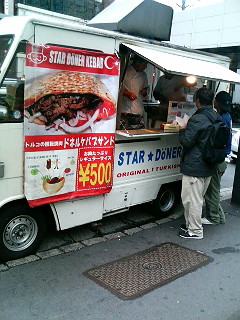



k e b a b + k u i s i n e
 IN A LOT OF BIG WESTERN CITIES LIKE SYDNEY, LONDON AND COPENHAGEN DENMARK, ONE OF THE BIG FEATURES OF STREETLIFE IS THE CORNERSHOP KEBAB JOINT. Suitably greasy and surrounded by threatening gangs of homeboys, these are the places where you fill up after a night on the town, and nothing compares to the taste of a piping hot kebab or fellafel when you are drunk or off your face. For budget travellers and backpackers, kebab shops are a lifesaver. Unfortunately for the budget traveller visiting Japan, the kebab fad hasn't caught on mainstream, although it is growing. There are a couple of doner kebab stands in Tokyo, all of them found in popular youth centers like Ueno and Akihabara and Shibuya. There are also a couple of vans that do the rounds in these youth areas, almost always manned by black or Middle Eastern guys who greet you with a friendly "Hey man" or "Hello, my friend". The range might seem disappointed to the average Australian or European -- usually there are just simple kebabs available, just chicken or beef, no vegetarian options, for a flat 500 Yen. Whatever you do, steer clear of the van at Yoyogi Park which serves banana fillings inside his kebabs. What kind of messed up sh!t is that -- putting mushed up banana gunk in a kebab! Then again, it would probably appeal to the warped tastebuds of the modern Japanese... For a more in depth look at the range of kebabs in Tokyo, click here.
IN A LOT OF BIG WESTERN CITIES LIKE SYDNEY, LONDON AND COPENHAGEN DENMARK, ONE OF THE BIG FEATURES OF STREETLIFE IS THE CORNERSHOP KEBAB JOINT. Suitably greasy and surrounded by threatening gangs of homeboys, these are the places where you fill up after a night on the town, and nothing compares to the taste of a piping hot kebab or fellafel when you are drunk or off your face. For budget travellers and backpackers, kebab shops are a lifesaver. Unfortunately for the budget traveller visiting Japan, the kebab fad hasn't caught on mainstream, although it is growing. There are a couple of doner kebab stands in Tokyo, all of them found in popular youth centers like Ueno and Akihabara and Shibuya. There are also a couple of vans that do the rounds in these youth areas, almost always manned by black or Middle Eastern guys who greet you with a friendly "Hey man" or "Hello, my friend". The range might seem disappointed to the average Australian or European -- usually there are just simple kebabs available, just chicken or beef, no vegetarian options, for a flat 500 Yen. Whatever you do, steer clear of the van at Yoyogi Park which serves banana fillings inside his kebabs. What kind of messed up sh!t is that -- putting mushed up banana gunk in a kebab! Then again, it would probably appeal to the warped tastebuds of the modern Japanese... For a more in depth look at the range of kebabs in Tokyo, click here.
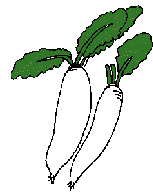


m e x i c a n + c u i s i n e
IT MIGHT COME SERVED IN AN AMERICANIZED AND JAPANOFIED RANGE OF FLAVORS -- but nonetheless, there is plenty of Mexican food to be found in Tokyo. It doesn't quite match the Mexican food that is available in Mumbai or Kuala Lumpur, however. But it sure beats the Mexican selection in Sydney or Reykjavik. Some suggestions:
El Torita: Odakyu Southern Tower
1st Floor, Shibuya. Phone: 03/5351 7074.
Some of the other addresses for this chain in Tokyo:
Tokyo, Japan
5-1-3 Minami-Aoyama
Aoyama La Mia Building 3rd Floor
Phone: 03-5466-7917
Tokyo, Japan
2-6-14 Izumi
Eifuku-Cho
Phone: 03-5376-7611
Nishi-Ku Yokohama-Shi, Japan
2-29-1 Takashima Mishi-Ku
Yokohama Sky Building 28th floor
Phone: 03-5696-7488
Tsukuba-Shi, Japan
2-16-4 Amakubo
Tsukuba Gakuen
Phone: 02-9850-2012
Shibuya, Tokyo, Japan
Hai Manten Jinnan Bldg. 1B
1-19-3 Jinnan Shibuya-Ku
Phone: 03-5459-6681
.
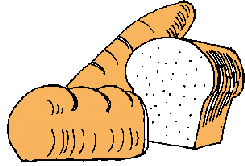


p a n - a s i a n + c u i s i n e
 TOKYO HAS PLENTY OF PLACES WHICH PRESENT A
MIXED ASIAN SPREAD FROM A VARIETY OF ASIAN COUNTRIES -- I guess you
could call this Pan Asian Cuisine. Pan as in
representing the whole of Asia, not in that it is cooked in a
pan -- he! he! he! Jokes aside, Tokyo is teeming with Asian
themed restaurants and eateries, and while purists might
scoff, these places are actually great spaces to chill out
and take a culinary journey across the largest continent on Earth.
TOKYO HAS PLENTY OF PLACES WHICH PRESENT A
MIXED ASIAN SPREAD FROM A VARIETY OF ASIAN COUNTRIES -- I guess you
could call this Pan Asian Cuisine. Pan as in
representing the whole of Asia, not in that it is cooked in a
pan -- he! he! he! Jokes aside, Tokyo is teeming with Asian
themed restaurants and eateries, and while purists might
scoff, these places are actually great spaces to chill out
and take a culinary journey across the largest continent on Earth.
Dong Khoi: Eitaidori, Shinkawa 1-chome.
On
first impression this looks like a Vietnamese restaurant, what was
with the Vietnamese sounding name and all (all Viets out there:
sorry I couldn't do the correct accents over the letters -- my
computer does not read or write Vietnamese script!) However, Dong
Khoi is actually a panAsian restaurant serving food from
such farflung cuisines as Nepal, Malaysia and China. Talk about it
mixing it up on the Asian tip! The restaurant is just down the road
from the green sail shape of the Coredo
Department Store, near the Sumida River.
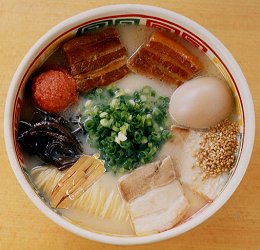



r a m e n -- ラーメン
NOT FOR THE WEIGHT CONSCIOUS, BUT DELICIOUS AND ESPECIALLY SATISFYING ON A COLD DRY DAY IN THE MIDDLE OF WINTER -- ramen noodles are on sale all over Tokyo. For a more in depth look at the range of ramen in Tokyo, click here.
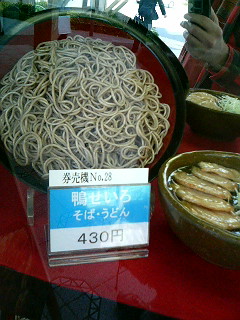



s o b a + c u i s i n e
 SOBA IS ONE OF THE ORIGINAL CUISINES OF JAPAN, AND SHOULD BE EATEN BY EVERY FOREIGN VISITOR AT LEAST ONCE IN HIS OR HER SOJOURN THROUGH JAPAN. In short, soba noodles are native Japanese noodles made of buckwheat flour (soba ko) and wheat flour (komugi ko). They are roughly as thick as spaghetti, and prepared in various hot and cold dishes. The most basic soba dish is zaru soba in which boiled, cold soba noodles are eaten with a soya based dipping sauce (tsuyu). This is great for a hot summer's day in Tokyo, and you can buy this basic zaru soba dish from any convenience store for like 200 or 300 Yen, if you are short of cash. The standard form of soba is called kake soba, basically "soba in broth". Kake soba consists of cooked soba noodles in a bowl of hot broth made of dashi (stock), mirin, and shoyu (Japanese soy sauce) and topped with sliced negi (Welsh onions). These are two of the most basic kinds of soba, but there is much more to soba than this. In this evolving Tokyo City Dining Guide, I want to introduce you to the wonder of soba, and detail some of the many soba restaurants which adorn this vast metropolis. Unlike a lot of other great foods, you will never get fat from eating soba... in fact, it kind of makes you sort of lose weight, if that is possible? You will also never run out of great soba restaurants in which to eat, no matter how long you stay here. Here is a small selection of some of the places I have chanced upon so far, or at least chanced by:
SOBA IS ONE OF THE ORIGINAL CUISINES OF JAPAN, AND SHOULD BE EATEN BY EVERY FOREIGN VISITOR AT LEAST ONCE IN HIS OR HER SOJOURN THROUGH JAPAN. In short, soba noodles are native Japanese noodles made of buckwheat flour (soba ko) and wheat flour (komugi ko). They are roughly as thick as spaghetti, and prepared in various hot and cold dishes. The most basic soba dish is zaru soba in which boiled, cold soba noodles are eaten with a soya based dipping sauce (tsuyu). This is great for a hot summer's day in Tokyo, and you can buy this basic zaru soba dish from any convenience store for like 200 or 300 Yen, if you are short of cash. The standard form of soba is called kake soba, basically "soba in broth". Kake soba consists of cooked soba noodles in a bowl of hot broth made of dashi (stock), mirin, and shoyu (Japanese soy sauce) and topped with sliced negi (Welsh onions). These are two of the most basic kinds of soba, but there is much more to soba than this. In this evolving Tokyo City Dining Guide, I want to introduce you to the wonder of soba, and detail some of the many soba restaurants which adorn this vast metropolis. Unlike a lot of other great foods, you will never get fat from eating soba... in fact, it kind of makes you sort of lose weight, if that is possible? You will also never run out of great soba restaurants in which to eat, no matter how long you stay here. Here is a small selection of some of the places I have chanced upon so far, or at least chanced by:
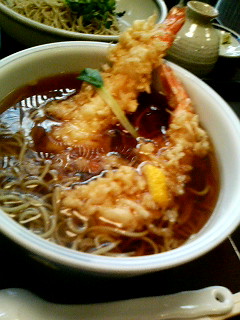 上野藪そば: 台東区上野6-9-16.
上野藪そば: 台東区上野6-9-16.
(Yakusoba Restaurant on Ueno-Okachimachi Chuo Street, near Ueno Station; formal address: 6-9-16 Ueno, Taito Ward.)
Phone: 03/3831 4728. Fax: 03/3835 0082. Map: map here.
It's funny how when you are in the flow,seemingly random events in life conspire to create an experience so thematic, it could have only been Divinely Designed. Sometimes the "themes" which pop up in a day are so tangible and contrived, I could almost hang the day on a single word. And they say we live in a random, arbitrary universe! Today is April 28 2006, and the word for today is "soba". I wasn't planning it that way, but that is the way it worked out, and in the process I broadened my understanding of the Tokyo soba scene. I also got a free lunch which is always a good thing! (and they say there is no such thing in life as a free lunch!) With my good friend Kuniaki Tasnaka I dined at the great Ueno Yakusoba Restaurant, located near Ueno Station in the teeming Okachimachi markets. Here is how it happened:
After waking up on one of the sunniest and most beautiful days of the year thus far, I remembered I had to go to the bank at Asakusa to get some money. Since I had a few spare hours before starting work,I decided to do a little research on the way for this here Tokyo Dining Guide,by taking photos of soba shops in the Asakusa area. Nothing more than that... "just looking" you might say,and I wasn't planning on actually eating anything, since I don't have the cash. But Fate was to prove me wrong, as I will shortly relate.
After reaching Asakusa and taking photos of the plastic foods display outside the Yamato Soba Restaurant, described immediately below, I got a phonecall from Mr Tanaka who said he was at Ueno having a drink at the Breaks Coffee Shop. Since it was in the area I headed over to Ueno to meet him. No sooner had I said hello when he said: "Are you hungry? Let's go to a good soba noodle restaurant near here?" So by dumb chance (if chance is dumb?) i got to eat in a real soba restaurant, and accumulated a little more information, to use in this Tokyo Dining Guide...
Upon taking a seat out our table, we were served soba cha, a kind of tea made from the oil left over from cooking soba noodles. Upon Mr Tanaka's recommendation, I ordered tempura soba, basically hot soba noodle soup with two prawn tempura pieces on top. As you can see in the photo, the broth is rich and brown and soyflavoured. In the photo you can also see a small chunk of orange peel -- it went down well and was a delicious touch!
The soba dishes range from about 700 to 2000 Yen -- hot or cold dishes are available.
Yakusoba is open from 11.30am to 9pm; closed every Wednesday.
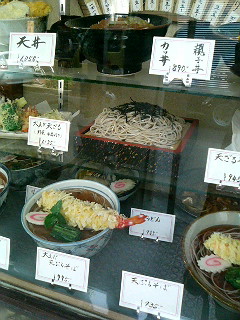 やまとそば: 台東区西浅草2-23-7.
やまとそば: 台東区西浅草2-23-7.
(Nishi Asakusa 2-23-7; near Kokusai Dori, on the main Kappabashi street.)
Phone: 03/3831 4728. Fax: 03/3835 0082. Map: map here.
Yamato is one of the most cliched names of Japanese dining (and manga and anime, as well). This soba restaurant is situated right in the heart of the plastic foods district at Kappabashi, near the great tourist attractions of Asakusa. If looking at all of that plastic food makes you hungry,stop by at Yamato Soba Restaurant where you can get the real thing. Some of the prices you can expect to pay, include 1050 Yen for tempura soba, although it is cheaper for the more basic noodle dishes.
You can see in the photo of the plastic food in the Yamato display window, there is a classic naruto swirl in one of the broths... I have been to the place they name that swirl after, the Great Swirls of Naruto Bridge. Click the link for your introduction to that place, on the beautiful island of Shikoku, Japan.
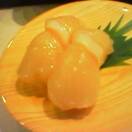



s u s h i + c u i s i n e
 OF COURSE SUSHI IS THE THING THAT MANY FOREIGNERS COMING TO JAPAN WANT TO TRY, AND EVERY CITY IN THE NATION IS DOTTED WITH ESTABLISHMENTS SELLING THIS MARVELLOUS FUSION OF RAW FISH AND VINEGARED RICE. Here is a slice of just some of the hundreds, thousands of sushi restaurants in Tokyo:
OF COURSE SUSHI IS THE THING THAT MANY FOREIGNERS COMING TO JAPAN WANT TO TRY, AND EVERY CITY IN THE NATION IS DOTTED WITH ESTABLISHMENTS SELLING THIS MARVELLOUS FUSION OF RAW FISH AND VINEGARED RICE. Here is a slice of just some of the hundreds, thousands of sushi restaurants in Tokyo:
日向丸 / Nikoumaru: (本店)東京都台東区浅草1−20−10 / 1-20-10 Asakusa, Taito Ward, Tokyo. TEL:03−5806−4222.
(田原町点)東京都台東区西浅草1−7−8 / Tawaramachi restaurant: 1-7-8 Nishi Asakusa, Taito Ward, Tokyo. TEL:03−3841−7033.
I could be wrong, but the name of this 回転 (sushi train) restaurant means "ship facing towards the sun" -- it is also the name of a famous ship in Japanese history. This was the first sushi train restaurant I ever dined at in Japan, and I have been eating there on-and-off for more than five years. The place was refurbished in late 2005, and while it is looking good now, some of the new features seem a little bizzare (for example there is a smoking section, but who the hell wants or needs to smoke while eating sushi?).
My friend K who has two hotels in Asakusa reckons that the sushi at 日向丸 isn't that good and that there are better options in the surrounding area. Perhaps my tastes aren't as refined as his, but on my last visit there, I didn't find the food too bad. In fact some of the plates I had -- in particular a strange but succulent salad number -- were quite divine. Prices range from 130Y for the stock-standard まぐろ and いか to 680Y per plate for raw sea urchin (生うに). K says there is no finer way to end a sushi meal, than to have a plate of raw sea urchin. It tastes like the ocean itself -- salty and vast. If you are sightseeing in the Asakusa/Tawaramachi areas (with all its temples and evocative sights/sites), you might consider lunch at 日向丸. Just make sure you are sitting away from the chain-smokers!




t e a r o o m + c u i s i n e
SOME TOKYO TEAROOMS:
See Kimberley's Kyushu for more about tea in Japan.
Umezono: 台東区浅草1-31-12.(1-31-12 Asakusa, Taito Ward.)
Phone: 03/3841-7580.
Opened in the 1st year of Ansei(1854). At first this parlor was opened beside the Umezonoin temple, a branch temple of the Sensoji temple, and was named after this temple. "Kuri Zenzai"(maron sweet 640yen) is known as a special product of this parlor. Both the millet from Okayama and the strained bean jam made of beans from Tokachi and steamed for half a day are specially good taste! They are the secret of the good taste of "Kuri Zenzai". We hear Kafu Nagai liked it.




t e m p u r a + c u i s i n e
SOME TEMPURA RESTAURANTS IN TOKYO:
Aoimarushin: 1-4-4, Asakusa, Taito-ku. Phone: 03/3841 0110.
According to one reviewer who knows: "Fifty years have already passed since this restaurant was opened on the Kaminarimon street in Asakusa.
It is in a eight storied building decorated a gigantic relief of lobster nearby "the Kaminarimon" in front of the gate of the Sensoji temple. The secret of the good taste of the dishes in this restaurant lies in the freshness of the material, sesame oil of good quality and the secret juice for tempura, which were taught from the founder who was a fresh fish dealer."




t o n k a t s u + c u i s i n e
 INVENTED IN THE 1930s, TONKATSU CONSISTS OF A BREADED, DEEP-FRIED PORK CUTLET (KATSU) SERVED WITH SHREDDED CABBAGE AND RICE. I took me a long while to warm up to tonkatsu -- in the beginning it reminded me of the overcooked, over fat saturated food my Mum used to cook back home in Australia. Then I realised the secret to enjoying tonkatsu (and getting through that mountain of shredded cabbage it comes with) -- you have to got to apply the sauces! And plenty of them too -- smother them with the sh!t! Tonkatsu can be eaten with a brown sauce uncreatively called Tonkatsu Sauce (トンカツソース), the ingredients of which vary from place to place but which usually has a taste similar to Worcestershire sauce or Kansas City-style barbeque sauce. In Nagoya, tonkatsu is eaten with a miso-based sauce. Some people also like to eat their tonkatsu with a spicy yellow mustard or soy sauce. Today I doused my cutlets with garlic sauce and found the results to my liking. In Japan they sell tonkatsu sandwiches in convenience stores and train stations, to varying degrees of culinary success.
INVENTED IN THE 1930s, TONKATSU CONSISTS OF A BREADED, DEEP-FRIED PORK CUTLET (KATSU) SERVED WITH SHREDDED CABBAGE AND RICE. I took me a long while to warm up to tonkatsu -- in the beginning it reminded me of the overcooked, over fat saturated food my Mum used to cook back home in Australia. Then I realised the secret to enjoying tonkatsu (and getting through that mountain of shredded cabbage it comes with) -- you have to got to apply the sauces! And plenty of them too -- smother them with the sh!t! Tonkatsu can be eaten with a brown sauce uncreatively called Tonkatsu Sauce (トンカツソース), the ingredients of which vary from place to place but which usually has a taste similar to Worcestershire sauce or Kansas City-style barbeque sauce. In Nagoya, tonkatsu is eaten with a miso-based sauce. Some people also like to eat their tonkatsu with a spicy yellow mustard or soy sauce. Today I doused my cutlets with garlic sauce and found the results to my liking. In Japan they sell tonkatsu sandwiches in convenience stores and train stations, to varying degrees of culinary success.
At least one would be tonkatsu connoisseur (とんかつの玄人) has complained: "I'm sure some tonkatsu connaisseur (sic) will tell me different but the problem with finding a good tonkatsu place is tonkatsu is pretty much universally similar. Sure there are places that taste better or have a higher quality of meat but at a basic level it's just battered deep fried pork. I'm not putting it down, I like tonkatsu but my point is with ramen, every store has their own soup, their own toppings, etc so it's easier to see some differences.
"Put another way, look through a book of ramen stores and nearly every ramen will look different. Look through a book of tonkatsu stores and i (sic) think most differences would be pretty subtle.
"Other than getting a grissly piece of pork or it being too greasy so far one tonkatsu place has been about the same as every other. (or maybe I just haven't learned to appriciate the differences)
Kimkatsu: Ebisu.
One tonkatsu lover visited this establishment and commented: "Went to Kimkatsu in Ebisu for some of their special brand of Tonkatsu. At Kimkatsu, the slice the pork thinly and layer it before they batter, bread and fry it. Really tasty stuff, and I'm sure it was worth the one hour wait."
昨晩恵比寿のキムカツでトンカツを食べに行った。キムカツのトンカツは豚肉を薄く切って重ねたものをあげる。すごい美味しかったから、1時間まったかいがあったかも。




v e g e t a r i a n + c u i s i n e
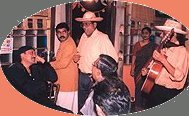 VEGETARIAN RESTAURANTS:
VEGETARIAN RESTAURANTS:
Gesshinkyo: Harajuku
Jingumae 4-24-12. Phone: 03/3796 6575.
The chef at Gesshinkyo has created his own rusticated version of shojin-ryori (Buddhist vegetarian cuisine), using exotic vegetables and grains from all over Japan. The 12,000-yen set menu (the only choice) has more than a dozen courses, each deceptively simple -- a small block of perfect sesame tofu topped by a crisp snow-pea pod, for example. Like the food, the setting is understated rather than showy: simple, private tatami rooms for two to four people, with hanging scrolls, a small flower arrangement in the corner, an.
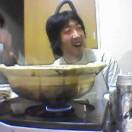




w h a l e + c u i s i n e
鯨専門店 / Kujira Sen Mon Ten: 東京都台東区浅草1-27-10 / 1-27-10 Asakusa, Taito Ward. Phone: 03/3841 0952.
This place is in the heart of the covered market near Sensouji Temple, in Asakusa. There is a restaurant and a shop dedicated to the sale of whale meat. On the restaurant menu I saw set meals going for a hefty 8000 yen (nearly US$100). In the shop, meantime, there were rows of marbled whale meat, and some pretty unusual cetacaen products, such as whale meat curry rice. I could hardly afford the 8000 yen set lunch, but I walked out the door with a can of tinned minke whale, which I intended to eat with beer at home. It tasted like whale always seems to taste -- chunky, not so bad, but then again a little bland. I wonder what the fuss is about whales being so delicious and so on? Then again, soon after eating my tinned whale, I felt a tingling in my skin which could indicate some healthy heating of the body or so forth -- but it could have just been from the herbs in the tin.
鯨屋 / Kujira-Ya: near corner of 109 Building and diagonally opposite the Book One bookstore, Shibuya.
This is one of the most well known whale meat joints in Tokyo, and has attracted plenty of foreign visitors looking for that slice of Heaven. Jonathon Delacour wrote: Kujira-ya (The Whale Restaurant) in Tokyo's trendy Shibuya district offers a complete whale-based cuisine including the three dishes I tried: sashimi, steak, and tonkatsu (crumbed and deep-fried)." A visiting BBC journalist was more colorful in his opinions: "All in all, it is a fascinating and delicious experience -- but then I guess animal rights campaigners would say that while whale, veal and pat・ス foie gras may all be tasty, they are also morally unacceptable."
I will leave it up to you whether you consider eating whale morally offensive, or no. But you can be sure of one thing -- given that whale harvesting is controversial and there are limits on the numbers of whale thus harvested, eating whale is always going to be expensive. Especially in Japan. Especially at this restaurant. Enough said.




i n t e r r a c i a l + f e s t i v a l s
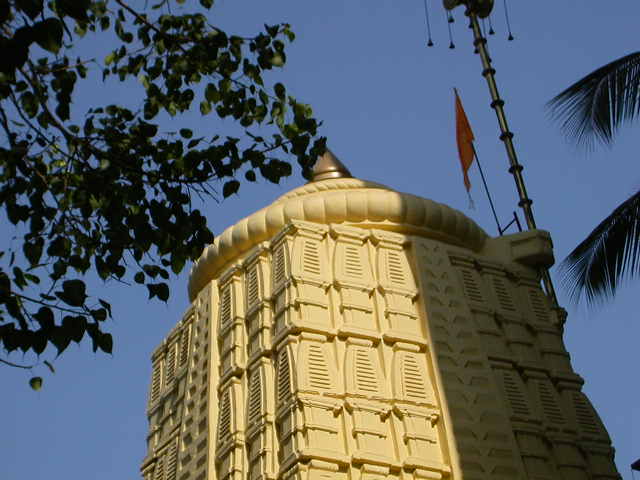 Tuesday 08 April 2003
The raw and the cooked (Cetacean)
Tokyo Oktoberfest in Hibiya: .
Tuesday 08 April 2003
The raw and the cooked (Cetacean)
Tokyo Oktoberfest in Hibiya: .
In typical Japanese fashion, this tribute to the great Munich Oktoberfest is held in the wrong month -- September! Nonetheless, it does testify to the growing popularity of German food in Japan. I for one was never interested in German food until I moved to Tokyo. Even the local convenience store (コンビニ) stacks a range of German related ready-to-eat goods, including the much loved "German Potato".
Held inside Hibiya Park and surrounded by Government ministry offices and some of the highest courts of the land, the Oktoberfest does manage to pull off a joyful and suitably boisterous mood, especially once enough amber fluid has been consumed. There is something ridiculous, however, about being forced to wait more than an hour in line to be served a plate of bland sausages and boiled pork, and then charged 1000 yen. The lines for German beer, on popular days, can also stretch past the one-hour mark, which puts a dent in any ambition to get qickly pished. Nonetheless, that is Japan -- overpriced, overcrowded, and overbland. If you are in Tokyo at the end of September and near Hibiya Park, you might as well check out Oktoberfest.
shibuya shopping | tokyo hotels
|
||||||
